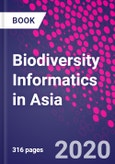Biodiversity Informatics in Asia: Status, Challenges, and Opportunities presents the most up-to-date information on biodiversity data across the Asian continent. It assesses the needs and gaps in current research and highlights the importance of biodiversity informatics to conservation and sustainability in Asia.
This book covers the most advanced lessons, technologies, and facilities gathering biodiversity data in Asia. It includes datasets for conservation, bio-prospecting, and ecological studies, and shares the best data standards and analytical tools to help further biodiversity informatics in Asian countries. This book also looks toward the future of biodiversity informatics and how factors such as networking, quality assurance, and geo-spatial platforms can be used for improvement.
Written and edited by lead experts in the field, Biodiversity Informatics in Asia: Status, Challenges, and Opportunities is a must-have for students and researchers analyze the data behind biodiversity and its connection to taxonomic conservation.
- Provides insight to biodiversity informatics specific to Asian regions
- Discusses the role of modern technology in biodiversity informatics, including cloud computing and social networks
- Analyzes the role of databases in changing taxonomic practices in Asia and presents strategies to improve these practices
Table of Contents
1. Biodiversity informatics and its development in Asia and around the globe 2. Advanced technologies and facilities associated with biodiversity informatics 3. Data standards and analytical tools in Asia 4. Biodiversity inventory and catalogue in Asia 5. Databases and associated websites on line in Asia 6. Roles of para-taxonomists and citizen science in Asia 7. Datasets in conservation, bio-prospecting and ecological studies 8. Good practices and lessons learned in Asia 9. Needs, gaps and ways ahead in biodiversity informatics and its application to conservation Appendix: Institutions, organizations and networks associated with biodiversity informatics in Asia








